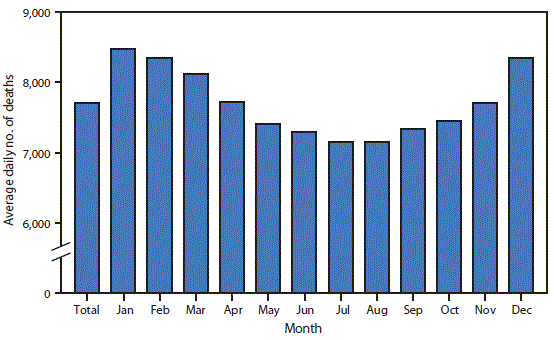Every year, roughly 2.8 million Americans shuffle off this mortal coil. In 2017, the CDC recorded exactly 2,813,503 deaths for an average of 7,708 deaths per day.
But averages can be misleading. You can drown in a body of water that has an average depth of one foot. The reason is because some parts are really deep and other parts are really shallow. The same logic applies to the average number of daily deaths. While the average is 7,708 per day, there is wide variability depending on the time of year.
Specifically, people are far likelier to die during the winter. New data released from the CDC show very clearly that the heart of winter -- December, January, and February -- are the deadliest months of the year. This may seem counterintuitive, given how much the media hypes summer heat waves. But the reality is that the summer months are actually the safest.

The CDC says that the average number of deaths in January, February, and December are 8,478; 8,351; and 8,344, respectively. By contrast, the summer months of June, July, and August recorded 7,298; 7,157; and 7,158 average daily deaths, respectively. The other months had daily averages somewhere in between those extremes, but it is notable that the relatively cooler spring and fall also exhibited a greater number of deaths than the summer.
What Can We Conclude from This Data?
It's tough to draw any conclusions from this data alone. So, we will need to rely upon some outside information. In general, we can draw three conclusions:
1) Summer heat waves are deadly, but winter is deadlier. This data does not imply that people should ignore summer heat waves. They can indeed be deadly. A heat wave that hit Europe in 2003 was thought to have killed 30,000 people. But while heat waves grab headlines, winter is the more insidious killer.
2) Winter is deadlier because of cold temperatures and influenza. Cold weather is inherently deadly. But it can kill indirectly, as well. It is thought that cold temperatures suppress our immune systems, making us likelier to get sick. (Yep, mom was right.) Perhaps that's why the flu season is almost always in the winter, with February often being the absolute worst month.
3) Any projections about the impact of climate change on weather-related deaths must take #1 and #2 into account. Usually, when the media discusses climate change, there is a focus on the increased number of deaths that may be caused by heat waves and catastrophes like floods. However, it should be kept in mind that winter is the deadliest season, so if global temperatures increase, we would expect fewer deaths during those months.*
*Update on 18-Jul-2019 @ 1:34 am PT. It was brought to my attention that this pattern of seasonal deaths is only to be expected in the rich world. Many of the poorer and more populated parts of the world are in or near the tropics, where summers are sweltering and winters are mild (or nonexistent). Thus, an increase in global temperatures would cause more deaths in these areas.
Source: "QuickStats: Average Daily Number of Deaths, by Month — United States, 2017." MMWR 68 (26): 593. Published: 5-July-2019. DOI: 10.15585/mmwr.mm6826a5

